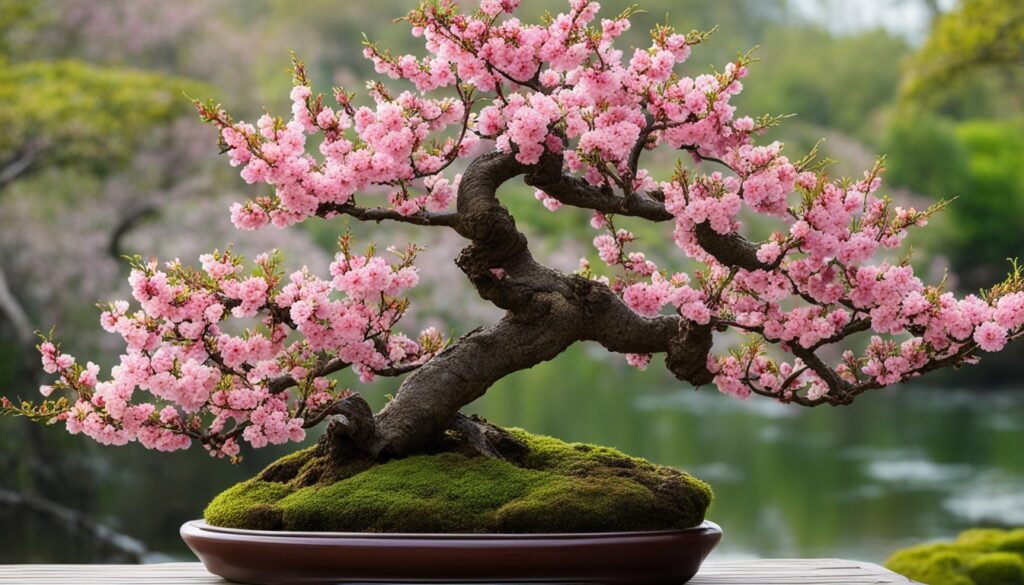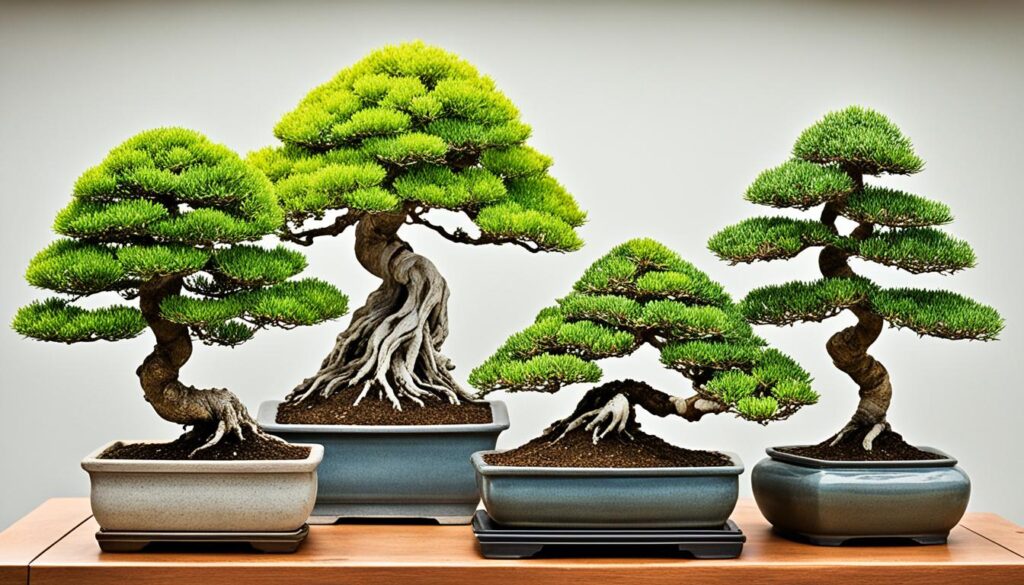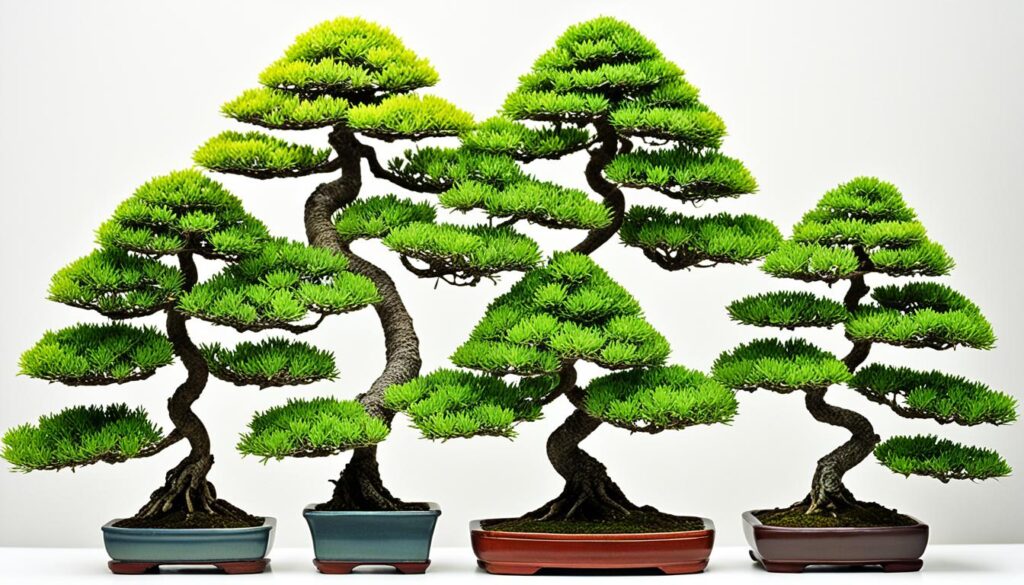Imagine a world where nature’s beauty fits right in your home. Indoor bonsai trees bring this magic to life. They turn small plants into beautiful pieces for any room. From the classic Ficus bonsai to the tough Dwarf jade plant, the elegant Fukien tea tree, and the beautiful Hawaiian umbrella tree, there’s a wide range of styles for indoor gardens.
These trees are not just pretty. They help clean the air, reduce stress, and bring peace to your space. They’re perfect for anyone, whether you know a lot about plants or are just starting. Growing your own bonsai tree can be a rewarding journey.
Key Takeaways
- Indoor bonsai trees offer a diverse array of varieties, each with unique features and care requirements.
- These miniature trees can thrive in small spaces, making them ideal for apartments and homes.
- Bonsai trees provide air purification, stress reduction, and a sense of tranquility to indoor environments.
- Ficus, Dwarf jade, Fukien tea, and Chinese elm are among the popular indoor bonsai tree types.
- Proper care, including watering, pruning, and soil management, is essential for the long-term health of indoor bonsai trees.
Introduction to Indoor Bonsai Trees
Bonsai trees are small wonders that capture the hearts of many. They can live indoors, adding beauty and peace to any room. Growing bonsai trees indoors is great for those with little outdoor space or who love these tiny art pieces.
Benefits of Growing Bonsai Indoors
Indoor bonsai are small, fitting well in small homes or apartments. They are easy to care for, perfect for busy people who want to be close to nature. Trees like Ficus, Carmona, and Chinese elm do well indoors because they handle low humidity and are tough.
Indoor bonsai let you enjoy their beauty all year. They don’t sleep like outdoor trees do in winter. This makes them great for city living and easy-care bonsai.
“Bonsai trees are a living representation of the harmony and balance found in nature, and bringing them indoors allows us to connect with that tranquility on a daily basis.”
Adding bonsai trees to your home or office brings many benefits. They make your space calm and refreshing, helping your mind and spirit.
Ficus Bonsai – The Classic Indoor Variety
Ficus bonsai are a top pick for indoor plants. They are known for being tough and flexible. They can handle low humidity and fit well in many indoor settings. Their slender trunks and soft leaves make ficus bonsai a beautiful addition to any space.
The indoor ficus tree is great for beginners. It’s a beginner-friendly bonsai that can handle indoor challenges like changing temperatures and light. It keeps its classic indoor bonsai look even in tough conditions.
“Ficus bonsai are the quintessential houseplant, offering a touch of nature and serenity to any living space.”
Whether you’re an expert or new to bonsai, the ficus bonsai is a great choice. It’s both beautiful and easy to care for indoors.

Dwarf Jade Plant – A Resilient Succulent Bonsai
The Dwarf jade plant, also known as the Portulacaria afra, is a compact and hardy succulent bonsai that thrives indoors. Its thick, fleshy leaves and sturdy trunk make it a great choice for indoor bonsai lovers. This easy-care bonsai is ideal for those looking for a compact bonsai tree that can handle different conditions.
Care Tips for Dwarf Jade Bonsai
To keep a Dwarf jade bonsai healthy, you need to provide the right conditions. Here are some important care tips:
- Ample Sunlight: The Dwarf jade bonsai loves bright, direct sunlight for 4 to 6 hours a day when it’s growing. In hot places, partial shade can protect it from leaf burn.
- Well-Draining Soil: Use a soil mix that drains well, made for succulents, to prevent the roots from getting too wet.
- Moderate Watering: Water the bonsai just right, letting the soil dry out fully between waters. Too much water can cause root rot.
- Balanced Fertilization: Feed the dwarf jade bonsai with a weak, balanced liquid fertilizer every two to four weeks when it’s growing.
By following these care tips for dwarf jade bonsai, your resilient indoor bonsai will flourish. It will be a low-maintenance, easy-care bonsai for your home or office.
Fukien Tea Tree – An Elegant Evergreen Bonsai
The Fukien tea tree, also known as the Carmona retusa, is a delicate and visually striking evergreen bonsai. It fits well in indoor settings. Its small, glossy leaves and graceful branches create a serene look. This makes it a favorite among bonsai enthusiasts.
The Fukien tea bonsai needs bright, indirect light and careful watering. This makes it a low-maintenance bonsai perfect for homes and offices.
This bonsai is great for indoor life. As an evergreen bonsai, it keeps its lush foliage all year. It’s also a great choice for small trees for homes. You can enjoy the beauty of a bonsai tree without needing a lot of space.
“The Fukien Tea Bonsai, also known as the Carmona Bonsai, symbolizes courage, heart, love & devotion.”
To care for the Fukien tea bonsai, you need to give it the right amount of light, water, and nutrients. These bonsai care tips help keep the tree healthy and its foliage stunning. With the right care, the Fukien tea bonsai can do well indoors. It’s a top pick for elegant indoor bonsai lovers.

The Graceful Hawaiian Umbrella Tree
The Hawaiian umbrella tree, or Schefflera, is a captivating hawaiian umbrella bonsai with unique foliage. It looks like an umbrella and has elegant branches. This tree loves bright, indoor spots and can be shaped into beautiful, compact bonsai trees.
Shaping and Pruning the Umbrella Tree
For the indoor umbrella tree, using bonsai shaping techniques is key. Regular pruning helps shape the tree’s canopy and grows new, healthy branches. By cutting back the right parts, bonsai lovers can make Schefflera trees look elegant and umbrella-like.
“The Hawaiian umbrella tree’s unique foliage and branching structure make it a captivating choice for indoor bonsai enthusiasts.”
The hawaiian umbrella bonsai is loved for its toughness and ability to adapt indoors. With practice in shaping and pruning, bonsai experts can turn this tree into a beautiful, small version of its natural self.
Sweet Plum Bonsai – A Flowering Delight
For those who love bonsai and want a touch of floral beauty, the sweet plum bonsai is perfect. This indoor bonsai, also known as the Sageretia, has small, delicate flowers that bloom in spring. They add a splash of color to any room.
The sweet plum bonsai has leaves that are small and glossy. They come in various shades of green, sometimes with red tinges in spring and autumn. This flowering bonsai needs a bit more care than some others. But, its beautiful flowers make it a great choice for those who love compact bonsai plants with blooms.
“Bonsai trees, including the sweet plum variety, symbolize peace, harmony, order of thoughts, balance, protection, health, wishes, new life, renewal, and creativity.”
To care for the sweet plum bonsai, place it in a bright, well-lit spot. Water it when the soil feels barely damp. Use a balanced bonsai feed to help it grow, produce fruit, and bloom. Pruning and styling are key to keeping the tree’s foliage and canopy looking great.
If you’re new or experienced with bonsai, the sweet plum bonsai is a great choice. It brings a touch of small flowering trees to your home. Its beauty and symbolic meaning make it a wonderful addition to any indoor bonsai with blooms collection.

Chinese Elm – A Versatile Indoor Bonsai
The Chinese elm, or Ulmus parvifolia, is a great choice for indoor bonsai. It has small, serrated leaves and a beautiful, twisting trunk. This makes it a favorite among bonsai lovers. You can shape it using wiring, pruning, and root techniques to make unique mini trees.
Training Techniques for Chinese Elm Bonsai
The Chinese elm bonsai is easy to train. If you want to be a bonsai gardener, you can use different methods to shape this indoor bonsai:
- Wiring: Use wire on branches and trunks to make beautiful, twisted shapes.
- Pruning: Prune carefully to keep the bonsai small and in shape.
- Root Manipulation: Work on the roots to improve the bonsai’s look and health.
These bonsai training methods help turn the Chinese elm into beautiful, artistic pieces. They are perfect for indoor display and bring joy to anyone who sees them.
“The Chinese elm bonsai is a true marvel of nature, showcasing the incredible adaptability and artistic potential of this versatile indoor plant.”
The Chinese elm bonsai is loved by bonsai fans worldwide. It’s hardy and has interesting growth patterns. This makes it a unique and rewarding plant to grow indoors.
What are some types of indoor bonsai trees?
Indoor bonsai trees come in many species perfect for homes and offices. Popular ones include the Ficus, Dwarf jade, Fukien tea, Hawaiian umbrella, Sweet plum, and Chinese elm. Each type has special traits that make them great for indoor growing, like being tough and small, or flowering seasonally.
The Ficus bonsai is a top pick for indoor spaces because it does well in low light and bounces back quickly after trimming. The Dwarf jade plant loves warm spots and is easy to care for. The Fukien tea tree brings elegance with its evergreen beauty.
Other favorites are the Hawaiian umbrella tree for its elegant look and the Sweet plum bonsai for its seasonal blooms. The Chinese elm is great for beginners because it’s easy to care for and adaptable.
These small trees can make your home or office feel more natural and calming. They’re perfect for anyone, whether you’re new to bonsai or have been growing them for years. These indoor bonsai types offer many choices for your space.

“The art of bonsai is not just about growing miniature trees; it’s about creating a living, breathing work of art that brings the beauty of nature indoors.”
Caring for Indoor Bonsai Trees
Lighting Requirements for Indoor Bonsai
Indoor bonsai trees need bright, indirect light to stay healthy and grow well. Most are from tropical or subtropical areas. They love warmth, light, and humidity. Using artificial lights like fluorescent or LED bulbs can help if there’s not enough natural light.
Good lighting keeps indoor bonsai looking great and strong. Trees like Ficus and Schefflera prefer rooms that are about 20ºC on average, with no colder than 15ºC. In winter, move them closer to windows for more light. In summer, keep them away from direct sunlight to prevent overheating.
Many beginners don’t realize how much light bonsai trees need. They often put them in places like shelves or desks. The best spots are kitchens and bathrooms because of the moisture, which keeps the air around the tree humid.
“Proper lighting is essential for maintaining the vibrant foliage and overall vigor of indoor bonsai.”
Getting your indoor bonsai enough light is key to keeping it healthy. By knowing what kind of lighting each bonsai tree needs, you can make sure it thrives indoors for years.
Watering and Fertilizing Indoor Bonsai
Keeping indoor bonsai trees healthy requires a careful balance in watering and fertilizing. These small plants have limited soil and nutrients. So, we must care for them with precision.
When watering indoor bonsai, it’s key to check the soil moisture. Water only when the top soil feels dry. Overwatering can harm them as much as underwatering. Experts suggest watching each tree to find the best watering time.
Feeding bonsai with a balanced, diluted liquid fertilizer keeps them nourished. Bonsai fertilizers have Nitrogen, Phosphorous, and Potassium (NPK). A good choice is Biogold, with an NPK of 6:7:4, perfect for compact bonsai maintenance and small bonsai care.
“The trend among experts is moving towards using a balanced fertilizer throughout the growth season and reducing its application towards the season’s end.”
For some bonsai, like those that flower, you might use more Phosphorous. Adjusting Nitrogen is also good for older trees. But, don’t overfeed them, as it can harm their health.

By watching how much water and fertilizer your bonsai gets, you can help them flourish in their small spaces.
Ideal Temperature for Indoor Bonsai Growth
Keeping the right temperature for indoor bonsai is key for their health. Tropical and subtropical bonsai like Ficus and Fukien tea do well in room temperatures between 65-75°F (18-24°C). This bonsai temperature requirement helps these small trees grow well indoors.
Adjusting for Seasonal Changes
When seasons change, you need to adjust your bonsai’s environment. This might mean adding heat or cooling to keep the ideal growing conditions for your small bonsai plants. Proper seasonal care for indoor bonsai is crucial for their health and vigor.
Some bonsai need a cold period to survive, lasting 6 to 8 weeks at 30°F to 40°F (0°C to 4°C). Meeting the maintenance of bonsai temperature requirements during this time is vital for your bonsai’s year-round health.
“Consistent temperature is key for the healthy growth of indoor bonsai. Monitoring and adjusting the environment as needed can make all the difference in the long-term success of your miniature trees.”
Knowing the ideal temperature for indoor bonsai and adjusting for seasons helps create the best environment. This ensures your bonsai plants stay beautiful and healthy.
Containers and Soil for Indoor Bonsai
To grow bonsai plants indoors, you need to pick the right containers and growing media. Use shallow, well-draining pots for bonsai to help roots grow and air to flow. The bonsai soil mix should be made just for these small bonsai trees. It should have a mix of fine materials like akadama, pumice, and organic stuff.
This special growing media for indoor bonsai keeps the right moisture and nutrients for these tiny trees. Soil quality is key to bonsai tree health; bad trees often have poor bonsai soil or garden soil.
Great bonsai soil needs to hold water, drain well, and breathe to help trees stay healthy and grow. You can use organic (like peat, leaf-litter, or bark) or inorganic (volcanic lava, calcite, baked clays) soil mixes for bonsai, each with its own benefits.
- Common parts of bonsai soil mixtures are Akadama, Pumice, Lava rock, organic potting compost, and fine gravel (grit).
- There are different bonsai soil mixtures for different trees, like deciduous and coniferous ones.
- For deciduous bonsai, the mix is 50% Akadama, 25% Pumice, and 25% Lava rock.
- For coniferous and Pine bonsai, the mix is 33% Akadama, 33% Pumice, and 33% Lava rock.
Picking the right container and bonsai soil mix is key for the health and growth of these tiny compact bonsai plants.

Pruning and Shaping Indoor Bonsai
Keeping indoor bonsai trees looking great means regular pruning and shaping. Experts use wiring, trimming, and root pruning to shape the trees. These methods help create beautiful, small trees that look like their full-sized versions, even inside.
Bonsai pruning is key for keeping trees healthy and small. Most trees need pruning 2 to 4 times a year, best in early spring or late autumn. For pines and some conifers, use your hands instead of scissors. Each bonsai type has its own care needs.
Bonsai shaping techniques like wiring and trimming are vital. The Formal Upright Style (Chokkan) is great for some conifers, giving a regal look. Styling bonsai means balancing the tree, removing dead parts, and shaping branches for a nice look.
Regular compact bonsai maintenance, including root pruning, helps control growth and improve water uptake. Prune during the dormant season to remove big branches, trim twigs, and balance the tree.
Learning bonsai pruning and shaping techniques lets enthusiasts create stunning bonsai. These trees can make small spaces feel like a part of nature.
“The true essence of bonsai is to create a miniature, yet living, work of art that captures the beauty and spirit of nature.”
Conclusion
Indoor bonsai trees bring nature’s beauty into small homes or apartments. They range from the classic Ficus to the elegant Hawaiian Umbrella. With the right care, these mini marvels can flourish indoors.
Choosing the right species and providing the right conditions is key. This way, you can enjoy the calm beauty of these low-maintenance houseplants every day.
The Jade Tree, Chinese Elm, and Japanese Maple are great for small spaces. They add beauty and calm to any room or office. These plants show the benefits of growing bonsai indoors.
For those new to indoor bonsai, it’s important to know what each tree needs. By learning about their care, bonsai lovers can grow a piece of art. This art brings peace and connects us to nature.


